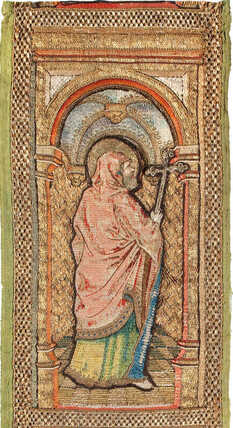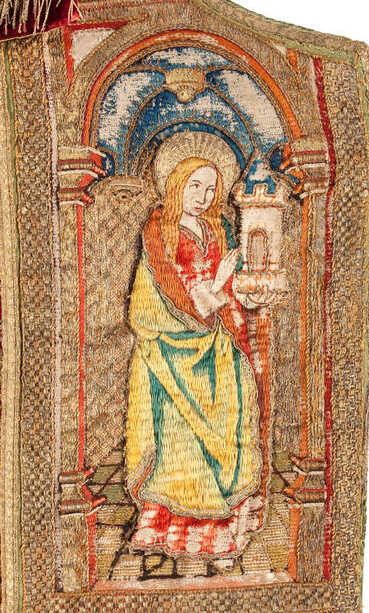|
Yesterday, I gave a brief introduction to the or nue embroidery on the vestments of the Order of the Golden Fleece held in the Imperial Treasury in Vienna, Austria for the 500th show of FiberTalk. My bit runs from 1:08:55 until 1:17:02. When I was preparing my pictures for this short presentation, it suddenly struck me that there were some similarities with a couple of pieces in the collection of the Museum Catharijneconvent in the Netherlands. Not exact matches, but enough similarities to propose that whoever drew the designs for the orphreys from the Catherijneconvent probably knew about the vestments of the Order of the Golden Fleece. Let me show you what I mean. Here you see an orphrey from the Mary cope of the vestments of the Order of the Golden Fleece and on the left an orphrey on cope BMH t622 in Museum Catharijneconvent. Can you see the similarities in the background architecture? The two columns with the arch and the two sharp triangles above look similar on both vestments. Even the colour scheme is the same. The actual blue vault is different in both pieces. In the orphrey on the left, we see a barrel vault and on the right, we see a groin vault. But they are both blue (a popular colour, but not the only one used). Yes, the embroidery on the orphrey from the Order of the Golden Fleece is much more elaborate and of higher skill, but I think the similarities are quite convincing. Interestingly, BHM t622 and ABM t2114 & ABM t2115 are the only orphreys with this type of simple quite bold architecture. But there is more. Something which has always intrigued me regarding ABM t2115 is the fact that the figure of Philip the Apostle is seen on the back. As far as I am aware, there are no other single-figure orphreys where this is the case. However, figures seen on the back are present on the copes of the Order of the Golden Fleece. The figures on the orphreys from Museum Catharijneconvent are worked in a form of long-and-short stitch characteristic of the medieval period. It is more worked like the systematic types of silk shading seen in Chinese embroidery than like the completely random type taught at the Royal School of Needlework. The figures in the vestments of the Order of the Golden Fleece are worked in or nue. However, in this case, both techniques are executed with a lot of skill. You cannot say that the or nue figures are of higher quality than the silk shaded ones (there is a difference in skill when you compare the backgrounds, see above). Again, the colour scheme in these two figures is remarkably similar. However, the drawings of the figures depicted on the vestments of the Order of the Golden Fleece are much more sophisticated. The figures from the Catharijneconvent orphreys are simpler and perhaps not so stylish. This is best illustrated when you compare the figure of Saint Barbara. Barbara on the left is hot, Barbara on the right not so much :). What is also interesting, the silk shading of Barbara on the right is of far lesser skill than that seen for the figure of Philip the Apostle. This indicates that the orphreys from the Catharijneconvent were stitched by embroiderers with different skill sets.
The vestments for the Order of the Golden Fleece were made around AD 1425-1440 in the Southern Netherlands. The orphreys from Museum Catharijneconvent were made c. AD 1490-1500 probably in the Northern Netherlands. Had the person who drew the design drawings for the orphreys from the Catharijneconvent seen a cope of the Order of the Golden Fleece? Perhaps when visiting the Order's chapel in Brussels? Or was this person perhaps even involved in the management of the vestments of the Order of the Golden Fleece? After all, they were already between 50 and 75 years old and must have received regular care to be preserved in such good state until the present day. Both embroiderers and designers needed an education before they could execute their professions. Maybe travelling to see famous vestments was part of their Continued Professional Development? Whatever the case, I think the similarities seen between the pieces in Vienna and those in the Netherlands show that there is a connection of some sort. What do you think? Literature Leeflang, M., Schooten, K. van (Eds.), 2015. Middeleeuwse Borduurkunst uit de Nederlanden. WBOOKS, Zwolle. Schmitz-von Ledebur, K., 2010. Das Messornat des Ordens vom Goldenen Vlies: Sticker im Dienste der burgundischen Herzöge, in: Bergemann, U.-C., Stauffer, A. (Eds.), Reiche Bilder. Aspekte zur Produktion und Funktion von Stickereien im Spätmittelalter. Schnell & Steiner, Regensburg, pp. 25–36.
13 Comments
Dear Jessica.
Reply
30/5/2022 18:20:41
Dear Andrejka,
Reply
Andrejka
30/5/2022 19:21:44
Dear Jessica.
Andrejka
30/5/2022 19:43:10
Dear Jessica. 30/5/2022 20:39:37
Dear Andrejka, 31/5/2022 09:16:40
Never a dull moment, Rachel, when you are working with 500-year old embroideries!
Reply
Andrejka
30/5/2022 21:26:05
Dear Jessica.
Reply
31/5/2022 09:22:17
Dear Andrejka,
Reply
Andrejka
31/5/2022 13:12:03
Your blogs are always very informative, and thought-provoking and it's a joy to hear your feedback on my thoughts.
Susan B Farmer
1/6/2022 00:42:03
Do they still think that Robert Campin (aka, The Master of Flemalle) did the cartoons for the Golden Fleece pieces? There's a lot of information (and phenomenal photographs) in Thurleman's book on Robert Campin.
Reply
1/6/2022 19:24:25
Not all vestments were made at the same time. Different painters have been suggested as inspiration for the design drawings: Andre Beauneveus, Hubert & Jan van Eyck, Master of Flemalle, Rogier van der Weyden, Hugo van Goes and Robert Campin. A good overview of which art historian said what up until 2010, can be found in: Brandner, C., 2011. Phänomene textiler Gewandbeobachtungen am Ornat des Ordens vom Goldenen Vlies. MA, Wien. Especially chaper 3 and 4.4.
Reply
Susan B Farmer
3/6/2022 10:14:23
Thanks for the paper reference. I'll have Interlibrary loan get me q copy! Your comment will be posted after it is approved.
Leave a Reply. |
Want to keep up with my embroidery adventures? Sign up for my weekly Newsletter to get notified of new blogs, courses and workshops!
Liked my blog? Please consider making a donation or becoming a Patron so that I can keep up the good work and my blog ad-free!
Categories
All
Archives
July 2024
|
Contact: info(at)jessicagrimm.com
Copyright Dr Jessica M. Grimm - Mandlweg 3, 82488 Ettal, Deutschland - +49(0)8822 2782219 (Monday, Tuesday, Friday & Saturday 9.00-17.00 CET)
Impressum - Legal Notice - Datenschutzerklärung - Privacy Policy - Webshop ABG - Widerrufsrecht - Disclaimer
Copyright Dr Jessica M. Grimm - Mandlweg 3, 82488 Ettal, Deutschland - +49(0)8822 2782219 (Monday, Tuesday, Friday & Saturday 9.00-17.00 CET)
Impressum - Legal Notice - Datenschutzerklärung - Privacy Policy - Webshop ABG - Widerrufsrecht - Disclaimer












 RSS Feed
RSS Feed